Mao Ye
School of Computer Science and Engineering, University of Electronic Science and Technology of China
Weakly-supervised Contrastive Learning with Quantity Prompts for Moving Infrared Small Target Detection
Jul 03, 2025Abstract:Different from general object detection, moving infrared small target detection faces huge challenges due to tiny target size and weak background contrast.Currently, most existing methods are fully-supervised, heavily relying on a large number of manual target-wise annotations. However, manually annotating video sequences is often expensive and time-consuming, especially for low-quality infrared frame images. Inspired by general object detection, non-fully supervised strategies ($e.g.$, weakly supervised) are believed to be potential in reducing annotation requirements. To break through traditional fully-supervised frameworks, as the first exploration work, this paper proposes a new weakly-supervised contrastive learning (WeCoL) scheme, only requires simple target quantity prompts during model training.Specifically, in our scheme, based on the pretrained segment anything model (SAM), a potential target mining strategy is designed to integrate target activation maps and multi-frame energy accumulation.Besides, contrastive learning is adopted to further improve the reliability of pseudo-labels, by calculating the similarity between positive and negative samples in feature subspace.Moreover, we propose a long-short term motion-aware learning scheme to simultaneously model the local motion patterns and global motion trajectory of small targets.The extensive experiments on two public datasets (DAUB and ITSDT-15K) verify that our weakly-supervised scheme could often outperform early fully-supervised methods. Even, its performance could reach over 90\% of state-of-the-art (SOTA) fully-supervised ones.
AGENT-X: Adaptive Guideline-based Expert Network for Threshold-free AI-generated teXt detection
May 21, 2025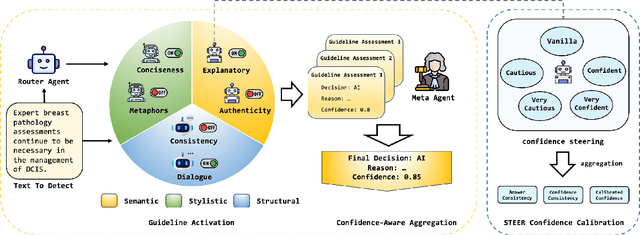
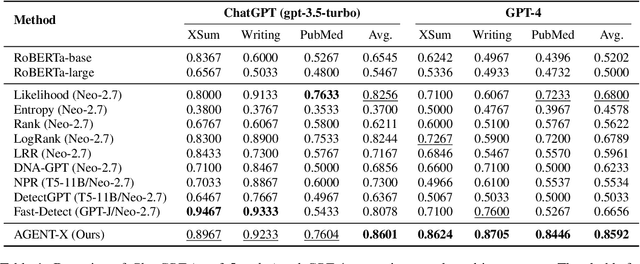
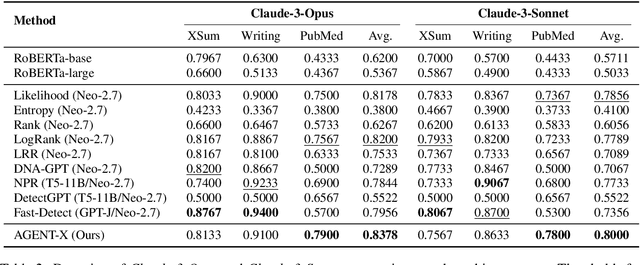
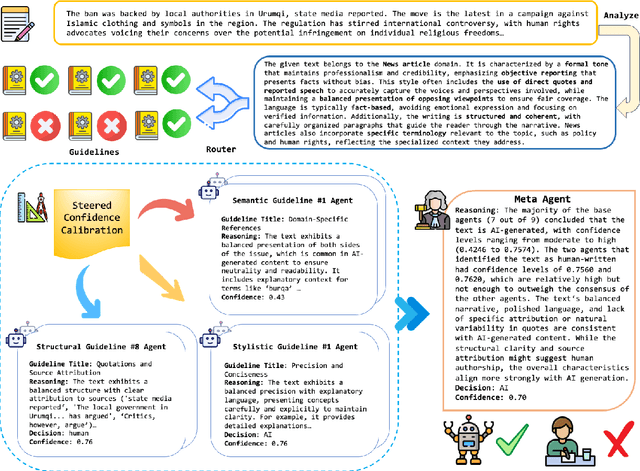
Abstract:Existing AI-generated text detection methods heavily depend on large annotated datasets and external threshold tuning, restricting interpretability, adaptability, and zero-shot effectiveness. To address these limitations, we propose AGENT-X, a zero-shot multi-agent framework informed by classical rhetoric and systemic functional linguistics. Specifically, we organize detection guidelines into semantic, stylistic, and structural dimensions, each independently evaluated by specialized linguistic agents that provide explicit reasoning and robust calibrated confidence via semantic steering. A meta agent integrates these assessments through confidence-aware aggregation, enabling threshold-free, interpretable classification. Additionally, an adaptive Mixture-of-Agent router dynamically selects guidelines based on inferred textual characteristics. Experiments on diverse datasets demonstrate that AGENT-X substantially surpasses state-of-the-art supervised and zero-shot approaches in accuracy, interpretability, and generalization.
High Dynamic Range Novel View Synthesis with Single Exposure
May 02, 2025Abstract:High Dynamic Range Novel View Synthesis (HDR-NVS) aims to establish a 3D scene HDR model from Low Dynamic Range (LDR) imagery. Typically, multiple-exposure LDR images are employed to capture a wider range of brightness levels in a scene, as a single LDR image cannot represent both the brightest and darkest regions simultaneously. While effective, this multiple-exposure HDR-NVS approach has significant limitations, including susceptibility to motion artifacts (e.g., ghosting and blurring), high capture and storage costs. To overcome these challenges, we introduce, for the first time, the single-exposure HDR-NVS problem, where only single exposure LDR images are available during training. We further introduce a novel approach, Mono-HDR-3D, featuring two dedicated modules formulated by the LDR image formation principles, one for converting LDR colors to HDR counterparts, and the other for transforming HDR images to LDR format so that unsupervised learning is enabled in a closed loop. Designed as a meta-algorithm, our approach can be seamlessly integrated with existing NVS models. Extensive experiments show that Mono-HDR-3D significantly outperforms previous methods. Source code will be released.
Bayesian Test-Time Adaptation for Vision-Language Models
Mar 12, 2025Abstract:Test-time adaptation with pre-trained vision-language models, such as CLIP, aims to adapt the model to new, potentially out-of-distribution test data. Existing methods calculate the similarity between visual embedding and learnable class embeddings, which are initialized by text embeddings, for zero-shot image classification. In this work, we first analyze this process based on Bayes theorem, and observe that the core factors influencing the final prediction are the likelihood and the prior. However, existing methods essentially focus on adapting class embeddings to adapt likelihood, but they often ignore the importance of prior. To address this gap, we propose a novel approach, \textbf{B}ayesian \textbf{C}lass \textbf{A}daptation (BCA), which in addition to continuously updating class embeddings to adapt likelihood, also uses the posterior of incoming samples to continuously update the prior for each class embedding. This dual updating mechanism allows the model to better adapt to distribution shifts and achieve higher prediction accuracy. Our method not only surpasses existing approaches in terms of performance metrics but also maintains superior inference rates and memory usage, making it highly efficient and practical for real-world applications.
Generative Data Mining with Longtail-Guided Diffusion
Feb 04, 2025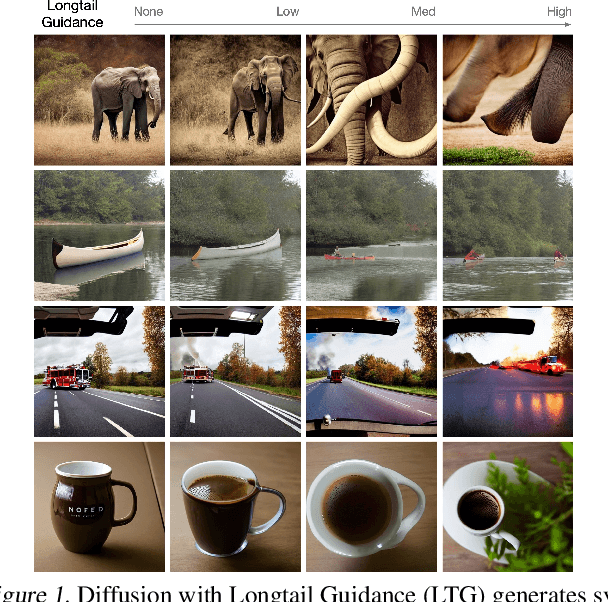
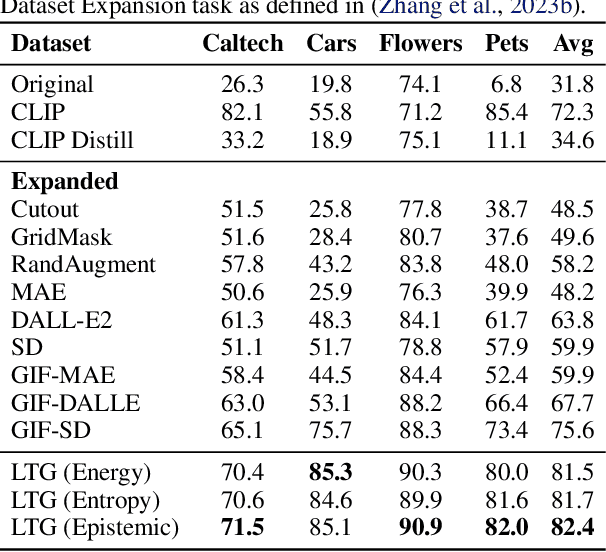
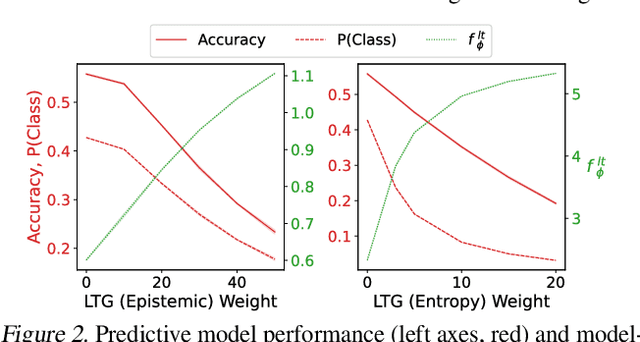
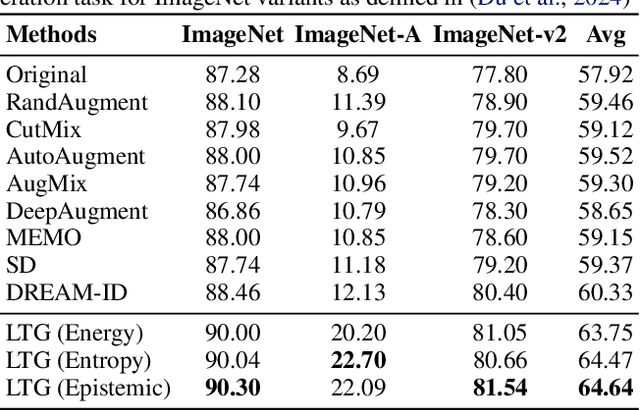
Abstract:It is difficult to anticipate the myriad challenges that a predictive model will encounter once deployed. Common practice entails a reactive, cyclical approach: model deployment, data mining, and retraining. We instead develop a proactive longtail discovery process by imagining additional data during training. In particular, we develop general model-based longtail signals, including a differentiable, single forward pass formulation of epistemic uncertainty that does not impact model parameters or predictive performance but can flag rare or hard inputs. We leverage these signals as guidance to generate additional training data from a latent diffusion model in a process we call Longtail Guidance (LTG). Crucially, we can perform LTG without retraining the diffusion model or the predictive model, and we do not need to expose the predictive model to intermediate diffusion states. Data generated by LTG exhibit semantically meaningful variation, yield significant generalization improvements on image classification benchmarks, and can be analyzed to proactively discover, explain, and address conceptual gaps in a predictive model.
Is Foreground Prototype Sufficient? Few-Shot Medical Image Segmentation with Background-Fused Prototype
Dec 04, 2024Abstract:Few-shot Semantic Segmentation(FSS)aim to adapt a pre-trained model to new classes with as few as a single labeled training sample per class. The existing prototypical work used in natural image scenarios biasedly focus on capturing foreground's discrimination while employing a simplistic representation for background, grounded on the inherent observation separation between foreground and background. However, this paradigm is not applicable to medical images where the foreground and background share numerous visual features, necessitating a more detailed description for background. In this paper, we present a new pluggable Background-fused prototype(Bro)approach for FSS in medical images. Instead of finding a commonality of background subjects in support image, Bro incorporates this background with two pivot designs. Specifically, Feature Similarity Calibration(FeaC)initially reduces noise in the support image by employing feature cross-attention with the query image. Subsequently, Hierarchical Channel Adversarial Attention(HiCA)merges the background into comprehensive prototypes. We achieve this by a channel groups-based attention mechanism, where an adversarial Mean-Offset structure encourages a coarse-to-fine fusion. Extensive experiments show that previous state-of-the-art methods, when paired with Bro, experience significant performance improvements. This demonstrates a more integrated way to represent backgrounds specifically for medical image.
OpenHumanVid: A Large-Scale High-Quality Dataset for Enhancing Human-Centric Video Generation
Dec 03, 2024



Abstract:Recent advancements in visual generation technologies have markedly increased the scale and availability of video datasets, which are crucial for training effective video generation models. However, a significant lack of high-quality, human-centric video datasets presents a challenge to progress in this field. To bridge this gap, we introduce OpenHumanVid, a large-scale and high-quality human-centric video dataset characterized by precise and detailed captions that encompass both human appearance and motion states, along with supplementary human motion conditions, including skeleton sequences and speech audio. To validate the efficacy of this dataset and the associated training strategies, we propose an extension of existing classical diffusion transformer architectures and conduct further pretraining of our models on the proposed dataset. Our findings yield two critical insights: First, the incorporation of a large-scale, high-quality dataset substantially enhances evaluation metrics for generated human videos while preserving performance in general video generation tasks. Second, the effective alignment of text with human appearance, human motion, and facial motion is essential for producing high-quality video outputs. Based on these insights and corresponding methodologies, the straightforward extended network trained on the proposed dataset demonstrates an obvious improvement in the generation of human-centric videos. Project page https://fudan-generative-vision.github.io/OpenHumanVid
Domain Adaptive Diabetic Retinopathy Grading with Model Absence and Flowing Data
Dec 02, 2024



Abstract:Domain shift (the difference between source and target domains) poses a significant challenge in clinical applications, e.g., Diabetic Retinopathy (DR) grading. Despite considering certain clinical requirements, like source data privacy, conventional transfer methods are predominantly model-centered and often struggle to prevent model-targeted attacks. In this paper, we address a challenging Online Model-aGnostic Domain Adaptation (OMG-DA) setting, driven by the demands of clinical environments. This setting is characterized by the absence of the model and the flow of target data. To tackle the new challenge, we propose a novel approach, Generative Unadversarial ExampleS (GUES), which enables adaptation from a data-centric perspective. Specifically, we first theoretically reformulate conventional perturbation optimization in a generative way--learning a perturbation generation function with a latent input variable. During model instantiation, we leverage a Variational AutoEncoder to express this function. The encoder with the reparameterization trick predicts the latent input, whilst the decoder is responsible for the generation. Furthermore, the saliency map is selected as pseudo-perturbation labels. Because it not only captures potential lesions but also theoretically provides an upper bound on the function input, enabling the identification of the latent variable. Extensive comparative experiments on DR benchmarks with both frozen pre-trained models and trainable models demonstrate the superiority of GUES, showing robustness even with small batch size.
FreeCap: Hybrid Calibration-Free Motion Capture in Open Environments
Nov 07, 2024
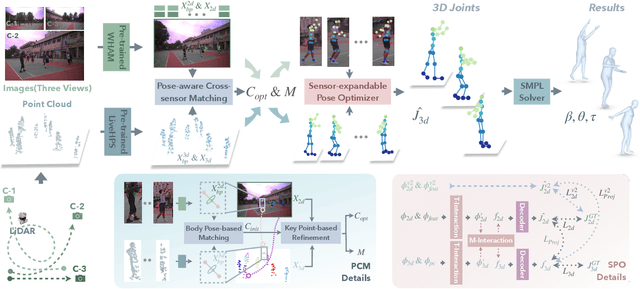


Abstract:We propose a novel hybrid calibration-free method FreeCap to accurately capture global multi-person motions in open environments. Our system combines a single LiDAR with expandable moving cameras, allowing for flexible and precise motion estimation in a unified world coordinate. In particular, We introduce a local-to-global pose-aware cross-sensor human-matching module that predicts the alignment among each sensor, even in the absence of calibration. Additionally, our coarse-to-fine sensor-expandable pose optimizer further optimizes the 3D human key points and the alignments, it is also capable of incorporating additional cameras to enhance accuracy. Extensive experiments on Human-M3 and FreeMotion datasets demonstrate that our method significantly outperforms state-of-the-art single-modal methods, offering an expandable and efficient solution for multi-person motion capture across various applications.
LGU-SLAM: Learnable Gaussian Uncertainty Matching with Deformable Correlation Sampling for Deep Visual SLAM
Oct 30, 2024Abstract:Deep visual Simultaneous Localization and Mapping (SLAM) techniques, e.g., DROID, have made significant advancements by leveraging deep visual odometry on dense flow fields. In general, they heavily rely on global visual similarity matching. However, the ambiguous similarity interference in uncertain regions could often lead to excessive noise in correspondences, ultimately misleading SLAM in geometric modeling. To address this issue, we propose a Learnable Gaussian Uncertainty (LGU) matching. It mainly focuses on precise correspondence construction. In our scheme, a learnable 2D Gaussian uncertainty model is designed to associate matching-frame pairs. It could generate input-dependent Gaussian distributions for each correspondence map. Additionally, a multi-scale deformable correlation sampling strategy is devised to adaptively fine-tune the sampling of each direction by a priori look-up ranges, enabling reliable correlation construction. Furthermore, a KAN-bias GRU component is adopted to improve a temporal iterative enhancement for accomplishing sophisticated spatio-temporal modeling with limited parameters. The extensive experiments on real-world and synthetic datasets are conducted to validate the effectiveness and superiority of our method.
 Add to Chrome
Add to Chrome Add to Firefox
Add to Firefox Add to Edge
Add to Edge